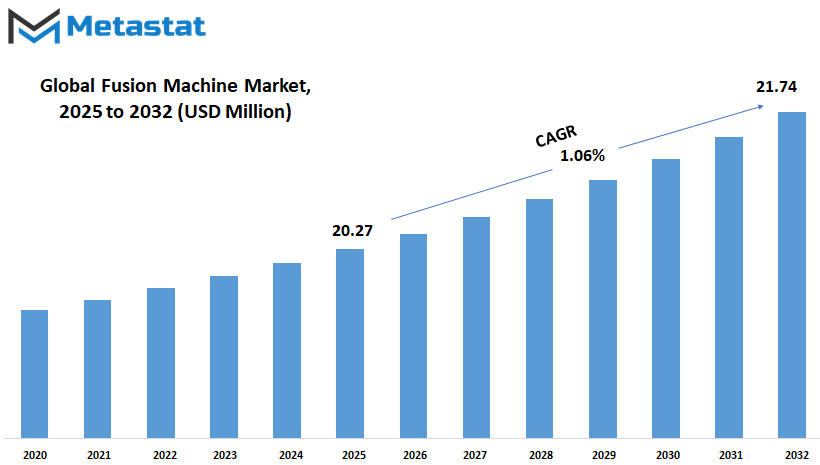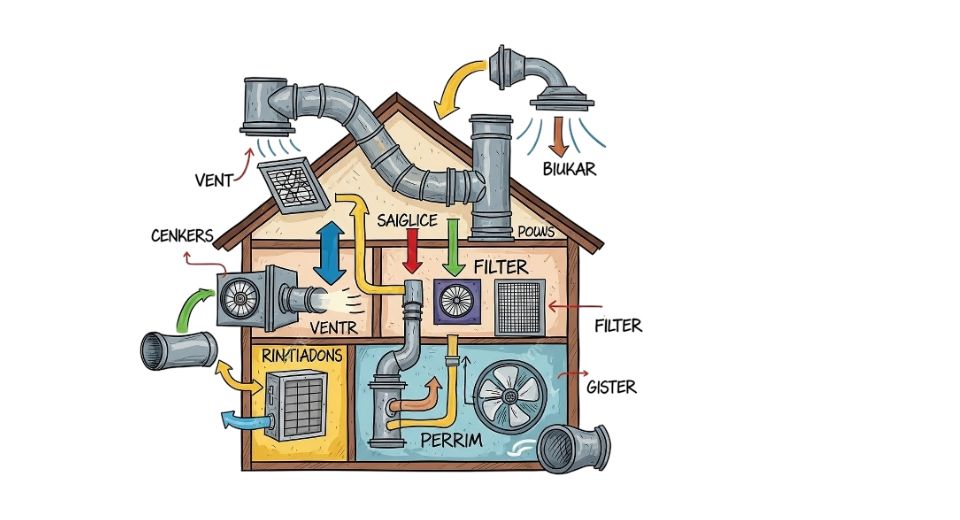MARKET OVERVIEW
The global fusion machine market, falling under the category of industrial manufacturing and infrastructure equipment, will establish a niche segment catering to machinery designed to couple thermoplastic pipes and fittings by heat processing. Such machines, crucial in pipeline systems, fluid transport networks, and utility distribution systems, will cater to industry segments such as water management, gas supply networks, mining, and telecom. The market will feature a broad spectrum of fusion technologies, including butt fusion, electrofusion, socket fusion, and saddle fusion, each defined by the specific pipe material, diameter, and performance characteristics.
The global fusion machine market will be influenced by the need for strong and leak-proof joints in high-stakes applications where system integrity is not an option. Fusion machines will be needed for both surface and buried pipeline installations, demanding equipment that can operate effectively across a wide range of environmental conditions. The working environment anything from urban infrastructure projects to isolated mining areas will demand highly reliable, portable, and automated fusion systems that are able to produce consistent results anywhere.
What will distinguish this market is the requirement of technical precision. In contrast to other pipe joining methods, fusion welding requires high precision in controlling parameters such as temperature, alignment, and pressure. The global fusion machine market will thus consist of machines with digital control panels integrated, real-time monitoring sensors, and automatic alignment technology. Producers will strive further to minimize operator reliance and mistake through the use of intelligent technologies and inbuilt quality control systems.
The market scope will grow across several geographic and regulatory environments, with equipment specs frequently required to correspond to regional industry standards. For example, equipment sold in North America and Europe can be made to meet ISO and ASTM pipe welding standards, but equipment shipped to developing economies might have to trade off cost savings for minimum performance guarantees. With increasing infrastructure needs worldwide, emphasis will be placed upon machines that are modulated, scalable, and versatile across various job sites and pipe networks.
Distribution-wise, the global fusion machine market will operate by a chain of direct manufacturers, approved distributors, and service integrators. Both government and private contractors who are in charge of utility and infrastructure construction will purchase the machines. Equipment rental companies will also be a significant medium, particularly in areas where usage on a project basis restricts the acquisition of permanent machine ownership. After-sales services, training of operators, calibration assistance, and software updates will become key to maintaining machine performance over the life of the equipment.
Additionally, the market will not just be limited to individual machines. It will also extend to related accessories and systems like data loggers, facing tools, pipe clamps, and cooling devices. This will provide an expanded ecosystem where machine compatibility and workflow integration are deciding factors. The global fusion machine market will remain at the crossroads of industrial technology and public infrastructure based on demands for operational accuracy, regulatory compliance, and equipment resilience in global construction settings.
Global fusion machine market is estimated to reach $21.74 Million by 2032; growing at a CAGR of 1.06% from 2025 to 2032.

GROWTH FACTORS
The global fusion machine market is likely to experience steady growth in view of a combination of encouraging trends and persistent challenges. The increased emphasis on clean and sustainable energy is among the primary driving forces for this market's potential. With nations looking for solutions to energy demands without jeopardizing the environment in the long run, fusion energy is becoming increasingly popular. Fusion machines are being considered as devices that could eventually provide a constant and safe source of power without the detrimental byproducts of other power sources. The prospect of having a power source that does not emit dangerous gases or produce long-term waste has encouraged various organizations and governments to invest in research and development of the machines.
Another contributing factor to the development of the global fusion machine market is the technological advancements in advanced material and magnetic systems. These advances have rendered it increasingly possible to sustain the extreme conditions required for fusion reactions. As more businesses and research institutions collaborate, it is reasonable to assume that breaks will keep coming until the prospect of useful fusion energy becomes reality. Foreign collaborations and long-term financing have also been instrumental in advancing projects, and these ties are likely to strengthen with time.
Some challenges remain in the market, nonetheless. One of the biggest of these is the cost and difficulty of assembling and keeping fusion machines under construction. These machines take specialty materials and precise control, which add to expenses but also require special labor and profound scientific understanding. Another factor that might limit growth is the long timeline before commercial use becomes viable. Fusion technology is still in development, and reaching the stage where it can be used on a large scale will take time and continued investment.
Even with these obstacles, the future holds several opportunities. If advancements progress, the global fusion machine market might provide new means of powering areas that now rely on conventional or contaminating sources. Government backing, along with private funding, has the potential to accelerate development and bring fusion energy to the masses. The encouragement toward green energy targets will also provide a window through which fusion machines can become an integral component of energy strategy in the future. With consistent developments and continuous support, this market can potentially revolutionize the way energy is generated in the future years.
MARKET SEGMENTATION
By Type
The global fusion machine market is likely to set the trend for a number of industries with its increasing application in spaces where precision, safety, and efficiency are required. With increasing demand for clean and more reliable sources of energy, fusion machines are being touted for being able to offer long-term solutions. These devices are not so much concerned with the generation of power; they are technologies that mirror the advancements of engineering and the ongoing quest for more effective and safer technology. Their impact ranges from industries dependent on controlled energy and precise functions, to providing a promising path for further development.
In the future, the industry is set to witness vigorous growth, fueled by innovation in the style of fusion machines being developed. One of the significant segments of this market is according to type, and these are Gas Benefits, Auto Electrical Benefits, and Manual Electrical Benefits. All of these types have different functions, depending on the given operations' needs. Machines with Gas Benefits provide a smoother and more constant energy source, which can be beneficial in environments where accuracy is most critical. Auto Electrical Benefits facilitate automation, saving industries time and minimizing the potential for human error. Manual Electrical Benefits provide more hands-on adjustment, which may be advantageous in applications where close monitoring or constant adjustments are needed.
In time, we can expect to see these classes merge attributes and develop hybrid machines that are more flexible and more efficient. This will drive the resulting tools toward being easier to use while maintaining robust, consistent output. As industries increasingly turn toward safer, cleaner solutions, the global fusion machine market will in turn turn its attention toward machines that are energy-efficient as well as easy to use.
Businesses are also going to spend more on research and development, producing machines that are smaller, quicker, and more adaptable to varied environments. This might allow for new applications in industries that have not embraced this technology as yet, keeping the market on the move. What is particularly thrilling is that fusion machines could ultimately reduce environmental footprint while enhancing productivity. This equilibrium between advancement and sustainability will most probably define the route that the market proceeds along in the coming years.
The global fusion machine market, by type, promises much in terms of defining the future as one where energy management is more intelligent, cleaner, and more efficient. Its trajectory will be one of a mix of innovation, function, and designs for the future.
By Application
The global fusion machine market is gradually attracting more attention as the globe seeks cleaner ways to produce energy. As concerns over conventional power sources and how they pollute the environment continue to grow, individuals are seeking alternative methods that may be cleaner, safer, and more sustainable. One of these alternatives is the utilization of fusion machines, which are used in an attempt to replicate the same energy process utilized by the sun. Utilizing this kind of energy source for other uses is increasingly popular, particularly as technology advances.
With further development of this technology, its application in various areas is expected by many. Industrial businesses will probably be one of the first industries to utilize these machines. Factories and manufacturing facilities require high levels of energy, and employing fusion-based systems can reduce costs while minimizing damage to the earth. Such businesses could also enjoy a consistent flow of energy provided by fusion as opposed to other sources that could be disrupted by weather or resource limitation. Through a more stable energy provision, industries will be capable of enhancing their production and fulfill increasing requirements without exerting additional strains on natural resources.
Universities and laboratories are, in a different direction, contributing a significant role in determining the future of the global fusion machine market. Besides being learning centers, universities and laboratories also function as testing sites for new technology. Working together as students and scientists, they will assist in creating improved and safer methods of constructing and maintaining these machines. Hands-on experience and learned knowledge will ultimately translate into practical application. With time, the studies conducted in such facilities will shift from theory to practice, and more sophisticated and dependable systems will be achieved.
In the future, the global fusion machine market may have a significant contribution to making energy generated and distributed globally. As time goes by, these machines may become compact, affordable, and simple to operate, enabling even more industries to utilize them. There will be an increasing demand for properly trained personnel who know how to run and service fusion machines. As interest from both the public and private sector grows, resources and funding will also increase. This movement could bring changes in energy consumption for the long term, ushering in a cleaner, more efficient future that is less dependent on old fuel sources.
|
Forecast Period |
2025-2032 |
|
Market Size in 2025 |
$20.27 million |
|
Market Size by 2032 |
$21.74 Million |
|
Growth Rate from 2025 to 2032 |
1.06% |
|
Base Year |
2025 |
|
Regions Covered |
North America, Europe, Asia-Pacific, South America, Middle East & Africa |
REGIONAL ANALYSIS
The global fusion machine market is slowly picking up steam in various regions of the world. With consistent technological progress and increased demand for cleaner energy alternatives, this industry is likely to see a change in the way regions utilize and invest in fusion technology. In terms of geography, the market is segmented into North America, Europe, Asia-Pacific, South America, and the Middle East & Africa. Each of these areas possesses some level of opportunity, based on their existing infrastructure, government assistance, and capabilities for research.
North America, particularly the U.S., is also forecast to be at the forefront in research and development. Strong public and private support in this area is likely to further define the capabilities of fusion machines. Canada and Mexico are also interested, particularly as carbon emissions are receiving more attention and long-term energy solutions are sought. In time, these nations could witness increased investment in training, infrastructure, and innovation aimed at strengthening their share in the global fusion machine market.
Europe is also a leader, with nations such as the UK, Germany, France, and Italy demonstrating steady engagement in fusion research. Supportive regulations and cooperative programs across frontiers portend a future where European countries cooperate closely to spearhead fusion machine development. With common aims and proximity to qualified labor and scientific expertise, Europe is in an ideal position to make tangible advancement in the area. The remainder of the region could also gain from these efforts through technology transfer and regional investments.
Asia-Pacific is similarly promising. India, China, Japan, and South Korea are also investing heavily in future energy systems. These nations have already taken significant strides in enhancing their energy profile, and their interest is likely to increase in the area of fusion technology. These countries have massive populations and growing demand for clean energy, so their drive for fusion machine advancement could accelerate rapidly. Even regions like those outside the large markets in this area may start looking into how they can contribute to and gain from these developments.
In South America and the Middle East & Africa, fusion power remains an emerging idea. Brazil and Argentina would consider the technology as international attention grows, with the rest of the region following in due course. In the same vein, GCC countries, as well as Egypt and South Africa, might gradually shift their eyes towards fusion devices as integral components of future energy solutions. As every region develops at its own rate, the world Fusion Machine market will keep increasing, providing new potential for energy generation and extended sustainability.

COMPETITIVE PLAYER
The global fusion machine market is gradually turning into a platform where future potential is complemented with fast-moving innovation. Organizations are not just developing machines to do things, but also looking ahead, defining how industries will work in the future. The concept of blending materials through precision and high-temperature methods is no longer confined to the laboratory or the research department. It is expanding into something much more industrialized, prevalent, and intricately linked to automation and intelligent systems.
With the growing demand for improved and more accurate sample preparation tools, Spectris, SPEX SamplePrep, and XRF Scientific are at the forefront with equipment that is getting smarter and more responsive. These machines are being designed with fewer opportunities for human error, less time consumption, and consistent quality. They are not simply tools they are components of systems intended to respond to the demands of contemporary testing and manufacturing. The expectation is that as industries shift toward faster and more controlled processes, the use of fusion machines will become more frequent and expected.
What is interesting about this market is how the various players are competing not merely on performance, but on long-term dependability, support, and integration simplicity. Fluxana, LGC, and HERZOG, for instance, are not merely marketing machines. They are delivering total solutions that integrate with existing lab configurations and even anticipate future requirements. Whether in terms of software compatibility, energy efficiency, or rugged build, these companies are thinking ahead.
Duolin and McElroy Manufacturing, Inc. have also demonstrated signs of evolution to what the future holds. Their effort now appears to shift towards creating machines that learn over time or engage with other devices in more intelligent manners. Fusion Equipment, another significant competitor, seems to be constructing machines that are smaller but powerful, providing labs and assembly lines with the flexibility that they tend to require.
The global fusion machine market, in its outlook from the future, will tend toward more automation and more remote operation. Industrially, when smartening their operations, all machinery involved in material preparation cannot be exempt from this trend. They will be driven to process more data, make finer adjustments, and run for longer periods under minimal supervision.
Competition in this marketplace is no longer simply who can produce the best thing today. It is increasingly about who will get to control how these machines operate tomorrow. The players who get it and embrace it will probably be leading, and others will be trailing.
Fusion Machine Market Key Segments:
By Type
- Gas Benefits
- Auto Electrical Benefits
- Manual Electrical Benefits
By Application
- Industrial Enterprises
- Universities & Laboratories
Key Global Fusion Machine Industry Players
- Spectris
- SPEX SamplePrep
- XRF Scientific
- Fluxana
- LGC
- HERZOG
- Duolin
- McElroy Manufacturing, Inc.
- Fusion Equipment
WHAT REPORT PROVIDES
- Full in-depth analysis of the parent Industry
- Important changes in market and its dynamics
- Segmentation details of the market
- Former, on-going, and projected market analysis in terms of volume and value
- Assessment of niche industry developments
- Market share analysis
- Key strategies of major players
- Emerging segments and regional growth potential








 US: +1 3023308252
US: +1 3023308252






